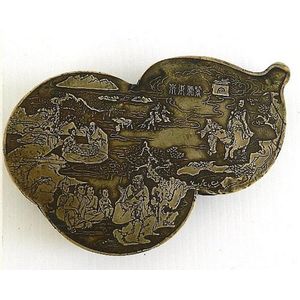Australian Gold Signet Ring with Kangaroo and Emu Motifs
An Australian gold signet ring, attributed to Robert Robertson, Collins Street, Melbourne, circa 1860 with a shield shaped cartouche engraved with script initials 'JH', the shoulders cast and chased with a kangaroo and an emu, twice marked 'Lion Rampant / RR / Thistle', 18 carat gold. Reference: In 1820 Robert Robertson was born in Cupar, Fife and migrated to Australia in 1852, starting a jewellery business in Collins Street in 1854, and later moving to Little Collins Street. A silver trowel with the same hallmark as this ring, thought to be by Robertson, was in the 1988 Kozminsky Bicentennial Exhibition, Australian Silver Gold & Jewellery. Given Robertson's Scottish background, and coping Glasgow's hallmarks of the Thistle and Lion Rampant, adds weight to the attribution of this mark to Robert Robertson
You must be a subscriber, and be logged in to view price and dealer details.
Subscribe Now to view actual auction price for this item
When you subscribe, you have the option of setting the currency in which to display prices to $Au, $US, $NZ or Stg.
This item has been sold, and the description, image and price are for reference purposes only.
- Cartouche - An ornamental panel in the form of of a shield, oval or rectangular scroll with curling edges. It may be carved into the back of a chair or the top of a sideboard, or present on a piece of silver or jewellery, and contain the initials of the original owner, heraldic symbols, or some other inscription, such as the details of a presentation.
In ceramics the term defines the central area of a vase or similar with a decorative border in one of the shapes above, into which a decorative scene or figures have been painted. - Attributed - A cataloguing term where the item in the opinion of the cataloguers, is a of the period of the artist, craftsman or designer, and which probably in whole or part is the work of that person.
- Circa - A Latin term meaning 'about', often used in the antique trade to give an approximate date for the piece, usually considered to be five years on either side of the circa year. Thus, circa 1900 means the piece was made about 1900, probably between 1895 and 1905. The expression is sometimes abbreviated to c.1900.
- Carat - A carat (abbreviated "ct") is a unit of measurement used to describe the weight of a diamond or other gemstone, and separately is a unit of measurement used to describe the weight of precious metals such as gold,.
For gemstones, one carat is equal to 0.2 grams or 200 milligrams. The weight of a diamond is one of the Four Cs (along with cut, colour, and clarity) that are used to determine a diamond's value.
It is important to note that a diamond's weight does not necessarily correspond to its size. A diamond's cut, which affects how well it reflects light, can make a diamond of a lower weight appear larger than a diamond of a higher weight. Additionally, the carat is not the only factor to determine the value of a diamond, other factors such as clarity, colour and cut are important too.
In the gold industry, the purity of gold is measured in carats (abbreviated "ct"), with 24 karats being pure gold and lower carat numbers indicating a lower purity level. So, for example, 18 carat gold is 18/24 or 75% pure gold, and 12 carat gold is 12/24 or 50% pure gold.
This item has been included into following indexes:
Visually similar items

A Chinese metal gourd form box
Sold by
in
for
You can display prices in $Au, $US, $NZ or Stg.

A gold ring by Matcham Skipper, of figural design, in 18ct gold, ring size K-L
Sold by
in
for
You can display prices in $Au, $US, $NZ or Stg.

Len Castle, press moulded rectangular stoneware platter with impressed motifs, impressed mark, 41.5 cm length
Sold by
in
for
You can display prices in $Au, $US, $NZ or Stg.

Len Castle, lidded stoneware box, with quince blossom decoration. Impressed initials to the base. Width 7 cm
Sold by
in
for
You can display prices in $Au, $US, $NZ or Stg.
